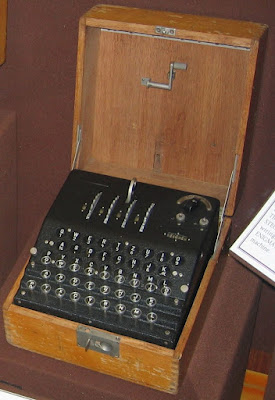Cryptography is the art of writing or solving coded writing.
The earliest known use of cryptography is found in non-standard hieroglyphs carved into monuments from the Old Kingdom of Egypt circa 1900 BC.
Ahmad al-Qalqashandi (1355–1418) wrote the Subh al-a 'sha, a 14-volume encyclopedia which included a section on cryptology. The list of ciphers in this work included both substitution and transposition, and for the first time, a cipher with multiple substitutions for each plaintext letter.
Binary code was invented in 1679 by German philosopher and mathematician Gottfried Wilhelm von Liebniz In search for a new mathematical model to replace the decimal system, von Liebniz read a 3000 year old Chinese book I Ching. Fascinated by the simplicity of Yin and Yang, Liebniz used this philosophy to create the binary number system.
The Vigenère Cipher, invented in 1553 and using various alphabets, was not cracked until 1854 by British computer pioneer Charles Babbage. No other code has taken as long to crack.
During the Second World War, Bletchley Park was the site of the United Kingdom's main decryption establishment, where ciphers and codes of several Axis countries were decrypted, most importantly the ciphers generated by the German Enigma and Lorenz machines.
Ahmad al-Qalqashandi (1355–1418) wrote the Subh al-a 'sha, a 14-volume encyclopedia which included a section on cryptology. The list of ciphers in this work included both substitution and transposition, and for the first time, a cipher with multiple substitutions for each plaintext letter.
Binary code was invented in 1679 by German philosopher and mathematician Gottfried Wilhelm von Liebniz In search for a new mathematical model to replace the decimal system, von Liebniz read a 3000 year old Chinese book I Ching. Fascinated by the simplicity of Yin and Yang, Liebniz used this philosophy to create the binary number system.
The Vigenère Cipher, invented in 1553 and using various alphabets, was not cracked until 1854 by British computer pioneer Charles Babbage. No other code has taken as long to crack.
During the Second World War, Bletchley Park was the site of the United Kingdom's main decryption establishment, where ciphers and codes of several Axis countries were decrypted, most importantly the ciphers generated by the German Enigma and Lorenz machines.
Below is the Enigma Model G, used by the German military intelligence service
American cryptanalyst Elizebeth Friedman broke 4,000 codes during World War II and brought down a Nazi spy ring across South America by cracking an early version of the Enigma machine with pen and paper. FBI Director J. Edgar Hoover took credit for her work until reports were declassified in 2008.
America recruited 29 Navajo speaking men during World War II, who later came to be called, Navajo code talkers. They had created a brand new set of code words in Navajo language, which even if intercepted could not be translated by the enemy forces.
For the many members of the Women's Royal Naval Service (Wrens) who worked at Bletchley Park, their posting was to HMS Pembroke V.
For the many members of the Women's Royal Naval Service (Wrens) who worked at Bletchley Park, their posting was to HMS Pembroke V.
Steganography is indeed a technique of hiding information within other information in such a way that it is not easily detectable by anyone who does not know where or how to look for it. This technique has been used throughout history for secret communication, both in times of war and peace.
Phyllis Latour Doyle was a British spy during World War II, who used knitting as a means of recording messages. Specifically, she would create codes using the spacing of the knit and purl stitches, and then encode messages by creating deliberate errors in the knitting pattern. To the untrained eye, the knitting would look like any other piece of knitting, but to those who knew the code, the hidden message could be easily deciphered.
Source Wikipedia
Source Wikipedia

No comments:
Post a Comment